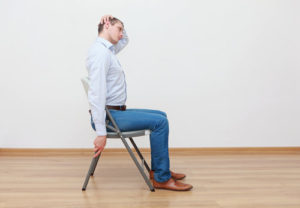Back pain is one of the most common types of pain seniors suffer from. It can be caused by arthritis, being overweight, bad posture, other internal problems, and even stress. There are some stretches that seniors with back pain can do without causing too much discomfort.

5 Stretches for Seniors with Back Pain
All these exercises should be done while sitting in a sturdy chair. Make sure to start each stretch with your feet firmly on the floor and knees at a ninety-degree angle.
1. Neck and Chest Stretch
This stretch works your scapulae and trapezius muscles in your neck and pectorals and in your erector spinae muscles.
Start with your feet planted on the floor and sitting straight. Put your hands at the base of your skull, fingers intertwined, thumbs running by your ears and down your neck. Ease your head back into your hands, putting your face toward the ceiling.
Inhale deeply, and as you breathe out, ease your left elbow, so it’s pointing towards the ground and right elbow toward the ceiling. Even if you only move an inch or two, that’s fine, just make sure you don’t hurt yourself.
Take two deep breaths and go back to your original position and then do the other side. Do this three times on each side, alternating sides.
2. Seated Gentle Backbend
This stretch works your spinal extensors, anterior neck muscles, and pectorals.
Bring your hands to your lower back, with fingers on your back and thumbs wrapped around your hips. Press your hands firmly into your hips/lower back and inhale.
As your breath out, gently arch your spine, leading with your head. Don’t force it too much, make sure you tilt your chin up with your face to the ceiling.
Hold this position for five full deep breaths and then slowly go back to the starting position. Do this three to five times.
3. Reach Back
This stretch will help with the range of motion in your shoulders and stretching your shoulders and chest.
Sit up straight and feet on the ground. Take a breath and breathe out as you reach behind you and interlace your hands. If you can’t connect your hands, you can grab opposite wrists or elbows.
Breathe in again and feel your spine growing longer as you sit up taller. Roll your shoulders up and backward, moving your shoulder blades down your back.
As you breathe out, gently straighten your arms, if your hands are clasped. If you are holding your elbows or wrists, gently pull in the opposite direction.
After three deep breaths, let go and go back to the beginning position. Do this three times.
4. Seated Cat-Cow
This stretch will work erector spinae, serratus anterior, iliac rib muscle, and external abdominal oblique, and rectus abdominous.
Put your hands on your knees with fingers pointing in toward each other and the heel of your hands on the outside of your legs. Breath in, and as you breathe out, press in your hands and arch your back, using your whole spine. Put your face toward the ceiling and push out your butt.
As you breathe in again, roll your shoulders forward and pull your belly button toward your spine. Drop your chin toward your chest and pushing toward your knees with your hands. When you breathe out, reverse the motion, pulling your chest through your arms and arching your spine again.
Do this slowly three to five times.
5. Gentle Twist
This stretch works your serratus anterior, erector spinae, rhomboids, and neck muscles.
Go towards the edge of the seat, but not too far that the chair tips over. Breath in and press down into your seat, sit up straight, and lift your arms up overhead.
As you breathe out, turn gently to the right, putting your left hand on the outside of your right knee and your right hand where feels comfortable. You want to feel the twist equally throughout your spine.
Stay in the twist as you breathe in, and you’ll feel yourself sit taller. As you breathe out, twist just a little deeper.
Take three to five deep breaths before gently releasing the twist and doing it on the other side.
Read more here.

